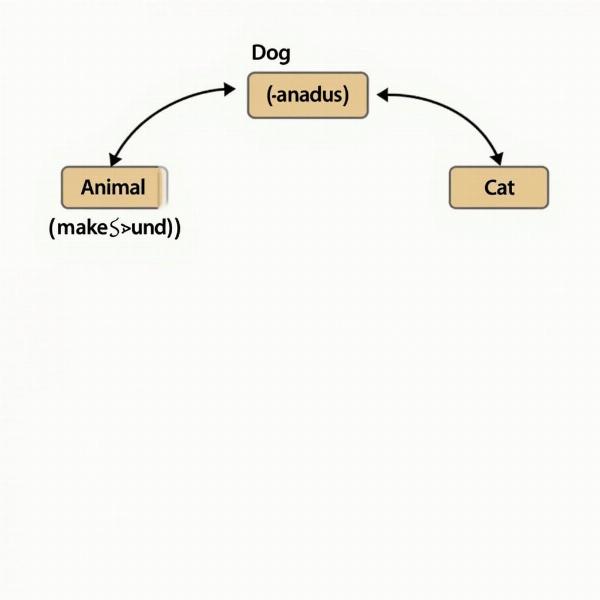Polymorphism, a cornerstone of object-oriented programming, allows objects of different classes to be treated as objects of a common type. Understanding its meaning in Hindi, along with its practical applications, is crucial for any programmer working with object-oriented languages like Java or C++. This article will delve into the Hindi meaning of polymorphism, explore its types, and illustrate its significance with real-world examples.
Understanding the Core Concept of Polymorphism
Polymorphism, derived from Greek words meaning “many forms,” signifies the ability of an entity to exist in multiple forms. In the context of programming, it allows a single interface to represent different underlying forms. Think of it like a universal remote control that can operate various devices like your TV, air conditioner, and music system. Similarly, polymorphism enables a single method or operator to behave differently depending on the object it’s interacting with. This flexibility and code reusability are major advantages offered by polymorphism.
Polymorphism in Hindi: बहुरूपता (Bahuruupta)
The Hindi word for polymorphism is बहुरूपता (Bahuruupta). This term accurately captures the essence of polymorphism, where “bahu” signifies “many” and “रूपता” (ruupta) signifies “forms.” This translation elegantly conveys the concept of multiple forms within a single entity. Understanding this Hindi term allows for a deeper appreciation of the concept within the Indian programming community.
Types of Polymorphism
Polymorphism manifests in two primary forms: compile-time (static) and runtime (dynamic).
Compile-Time Polymorphism
Compile-time polymorphism, also known as static polymorphism, is achieved through method overloading and operator overloading. Method overloading allows multiple methods with the same name but different parameters to exist within the same class. Operator overloading, on the other hand, allows operators like ‘+’ or ‘-‘ to have different functionalities depending on the operands.
Runtime Polymorphism
Runtime polymorphism, also known as dynamic polymorphism, is achieved through method overriding. This occurs when a subclass provides a specific implementation for a method that is already defined in its superclass. The actual method called is determined at runtime based on the object type.
 Runtime Polymorphism Example
Runtime Polymorphism Example
Real-World Examples of Polymorphism
Let’s consider some real-world examples to further solidify our understanding.
-
Shapes: Imagine a program dealing with various shapes like circles, squares, and triangles. Each shape can have a “draw” method. Polymorphism allows us to call the “draw” method on any shape object, and the correct drawing function for that specific shape will be executed.
-
Banking System: In a banking system, different account types (savings, checking, loan) might have a common “calculateInterest” method. Polymorphism ensures that the correct interest calculation is performed based on the specific account type.
Why is Polymorphism Important?
Polymorphism offers several advantages:
- Code Reusability: Reduces code duplication by allowing a single interface to interact with multiple object types.
- Flexibility: Enhances code flexibility and maintainability by allowing easy addition of new object types.
- Extensibility: Facilitates easy extension of existing code without modifying the core logic.
Conclusion
Polymorphism, or बहुरूपता (Bahuruupta) in Hindi, is a powerful tool in object-oriented programming that allows for flexibility, code reusability, and extensibility. Understanding its different types and applications is crucial for developing robust and maintainable software. By leveraging polymorphism, developers can create more efficient and adaptable programs.
FAQ
- What is the simple definition of polymorphism? Polymorphism allows objects of different classes to be treated as objects of a common type.
- What is the Hindi word for polymorphism? The Hindi word for polymorphism is बहुरूपता (Bahuruupta).
- What are the two main types of polymorphism? The two main types are compile-time (static) and runtime (dynamic) polymorphism.
- How is runtime polymorphism achieved? Runtime polymorphism is achieved through method overriding.
- Why is polymorphism important in programming? Polymorphism promotes code reusability, flexibility, and extensibility.
- Can you give an example of polymorphism? A shape drawing program where different shapes have a common “draw” method is an example of polymorphism.
- Is polymorphism only applicable to object-oriented programming? While most commonly associated with object-oriented programming, similar concepts can be found in other programming paradigms.
Meaning-Hindi.in offers professional translation services in Hindi and other languages, specializing in business, legal, technical, website localization, educational, and specialized translations. We provide accurate and culturally sensitive translations to bridge the communication gap between languages. For any translation needs, contact us at [email protected] or call us at +91 11-4502-7584. Let Meaning-Hindi.in be your trusted partner for all your translation requirements.